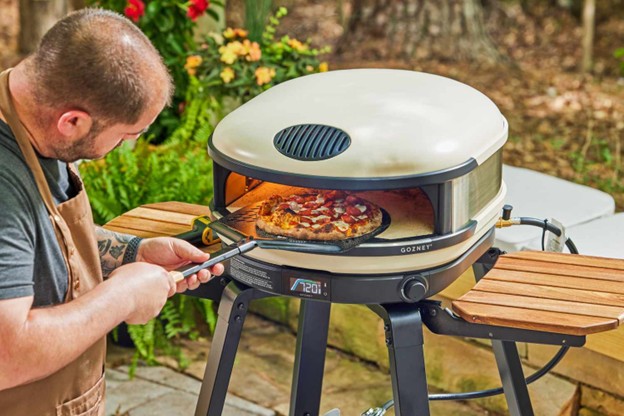Investing in an outdoor pizza oven will transform your outdoor cooking experience to a great extent. Within seconds, you can savor tasty pizzas among your friends and family. Designed to attain very high temperatures, outdoor pizza ovens differ from conventional kitchen ovens in guaranteeing crispy crusts and evenly cooked toppings in a few minutes. Pizza aficionados especially like these ovens since they produce an unparalleled rich, smokey taste. A well-built pizza oven improves your cooking flexibility and gives your outdoor area a fashionable touch whether your event is a backyard party or a peaceful supper outside.
Types of Fuel Available
Outdoor pizza ovens run on several fuels, each with special advantages and cooking techniques. Three primary choices are electric, gas, and wood-fired ovens. Real taste and high cooking temperatures from wood-fired pizza ovens give pizzas a crispy crust and smoky taste.
Convenience and stable temperatures made possible by gas-powered outdoor pizza ovensallow preheating quick-paced. For those who like a hassle-free cooking experience, they are perfect. Though less often used outdoors, electric pizza ovens offer accuracy and simplicity of use but might not reach the same high temperatures as wood or gas ovens. Your cooking style, the degree of temperature control you desire, and the maintenance work you are ready to commit will all affect the fuel type you choose.
Dimensions & Space Needs
Your outdoor area’s available space will determine whether you should go for a larger, more capacity oven or a smaller, more portable one. Consider the normal quantity of persons you prepare for. A larger oven will be required to fit several pizzas at once whether you have a huge family or are organizing major events.
Alternatively, if you want to use the oven mostly for personal or small-group use, a smaller, more portable choice could be enough. You also have to consider the area you intend to house the oven.
Make sure the ovens will suit your intended outdoor space including a patio, a deck, or your backyard. Carefully measure the area to guarantee the oven fits comfortably and that enough room exists for safety and ventilation.
Heat Retention and Transmission
Excellent heat holding and distribution capability define a successful outdoor pizza oven. The materials used in the construction of the oven and the insulation quality determine its capacity to retain heat. The excellent heat retention of traditional wood-fired brick ovens helps pizzas to cook uniformly at high temperatures.
Though modern stainless-steel ovens heat up quickly, if improperly insulated they may lose heat more rapidly. The heat dispersion of the oven also depends on its design. Circulating heat is best from a dome-shaped inside, which guarantees pizzas cook uniformly from all sides. Constant heat levels make the cooking process more fun and effective since they avoid the need for continuous monitoring and correction.
Cooking Time and Temperature Control
Reaching and preserving high temperatures are the fundamental characteristics of a top-notch outdoor pizza oven. Since a good pizza oven should be able to reach at least 700°F, pizzas can cook rapidly usually in a few minutes.
With temperatures of 900°F or more, certain professional-grade ovens produce a real Neapolitan-style pizza with a flawlessly browned crust. The type of oven determines how easily one may control temperature. While gas ovens give exact temperature control with adjustable burners, wood-fired ovens require manual adjustment by adding or reducing wood.
Maintenance and Ease of Use
A good outdoor pizza oven should be easily maintained and user-friendly. Though wood-fired ovens need more work in lighting and fire management, they offer a classic cooking experience that many pizza aficionados value. Alternatively, gas and electric ovens provide short startup times and ease.
Selecting outdoor pizza ovenswith robust and easily cleaned materials guarantees that years of hassle-free cooking will be yours. Frequent maintenance including cleaning the ash and checking the insulation helps the oven remain in the best shape and avoids performance problems.





